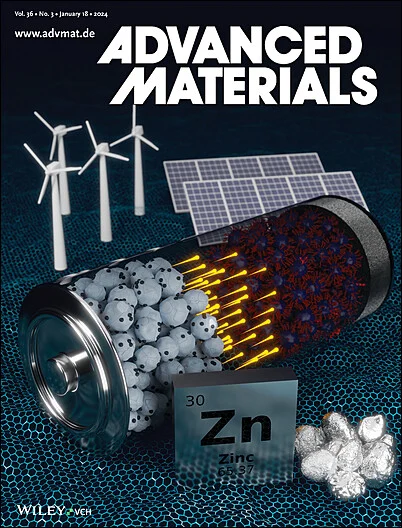High Entropy Fine-Tuning Achieves Fast Li+ Kinetics in High-Performance Co-Free High-Ni Layered Cathodes
IF 27.4
1区 材料科学
Q1 CHEMISTRY, MULTIDISCIPLINARY
引用次数: 0
Abstract
Co-free high-Ni layered cathode materials LiNixMeyO2 (Me = Mn, Mg, Al, etc.) are a key part of the next-generation high-energy lithium-ion batteries (LIBs) due to their high specific capacity and low cost. However, the hindered Li+ kinetics and the high reactivity of Ni4+ result in poor rate performance and unsatisfied cycling stability. This work designs a promising strategy for designing a high-performance high-entropy doping Co-free high-Ni layered cathode LiNi0.9Mn0.03Mg0.02Ta0.02Mo0.02Na0.01O2 (HE-Ni90-1.557) by elemental screening and compositional fine-tuning. Compositional fine-tuning optimizes the synergistic relationship between the high-entropy dopant elements, thereby significantly suppresses the kinetic hysteresis induced by Li+/Ni2+ mixing. The pillar effect significantly enhances the diffusion kinetics of Li+ at the high state of charge (SOC). Meanwhile, the high-entropy fine-tuning significantly postpones the H2-H3 phase transition and reduces the dissolution of transition metals and the loss of lattice oxygen in the cathodes. Consequently, the diffusion kinetics of Li+ at the atomic and electrode particle scales are significantly enhanced. The HE-Ni90-1.557 cathode exhibits an initial capacity of 225.1 mAh g−1 at 0.2 C and a full cell with a high capacity retention of 83.1% after 1500 cycles at 3C. This work provides a promising avenue for commercializing Co-free high-Ni cathodes for next-generation LIBs.

无钴高镍层状正极材料 LiNixMeyO2(Me = Mn、Mg、Al 等)因其高比容量和低成本而成为下一代高能锂离子电池(LIB)的关键部分。然而,由于 Li+ 动力学受阻和 Ni4+ 的高反应活性,导致其速率性能差,循环稳定性不理想。本研究通过元素筛选和成分微调,为设计高性能高熵掺杂无钴高镍层状阴极 LiNi0.9Mn0.03Mg0.02Ta0.02Mo0.02Na0.01O2 (HE-Ni90-1.557) 设计了一种可行的策略。成分微调优化了高熵掺杂元素之间的协同关系,从而显著抑制了 Li+/Ni2+ 混合引起的动力学滞后。支柱效应大大增强了高电荷状态(SOC)下 Li+ 的扩散动力学。同时,高熵微调大大推迟了 H2-H3 相变,减少了阴极中过渡金属的溶解和晶格氧的损失。因此,Li+ 在原子和电极颗粒尺度上的扩散动力学显著增强。HE-Ni90-1.557 阴极在 0.2 摄氏度下的初始容量为 225.1 mAh g-1,在 3 摄氏度下循环 1500 次后,电池容量保持率高达 83.1%。这项研究为下一代锂电池无钴高镍阴极的商业化提供了一个前景广阔的途径。
本文章由计算机程序翻译,如有差异,请以英文原文为准。
求助全文
约1分钟内获得全文
求助全文
来源期刊

Advanced Materials
工程技术-材料科学:综合
CiteScore
43.00
自引率
4.10%
发文量
2182
审稿时长
2 months
期刊介绍:
Advanced Materials, one of the world's most prestigious journals and the foundation of the Advanced portfolio, is the home of choice for best-in-class materials science for more than 30 years. Following this fast-growing and interdisciplinary field, we are considering and publishing the most important discoveries on any and all materials from materials scientists, chemists, physicists, engineers as well as health and life scientists and bringing you the latest results and trends in modern materials-related research every week.
 求助内容:
求助内容: 应助结果提醒方式:
应助结果提醒方式:


